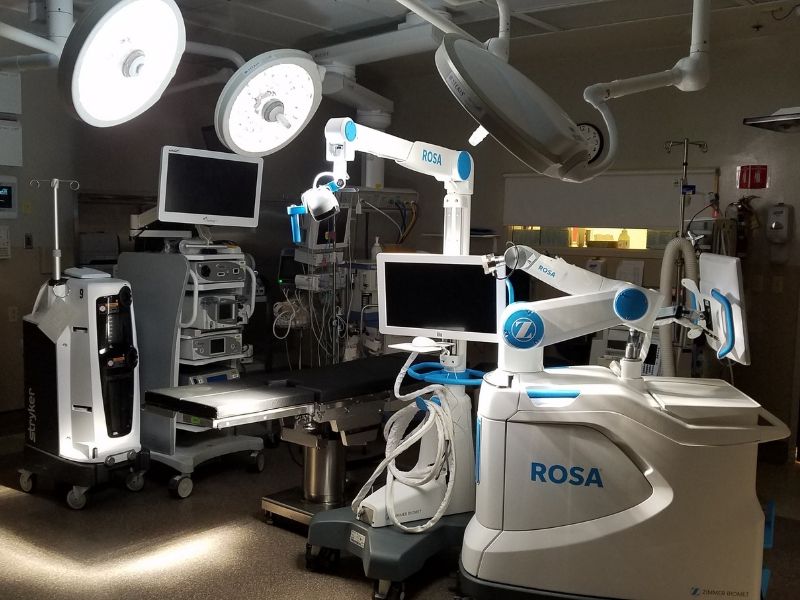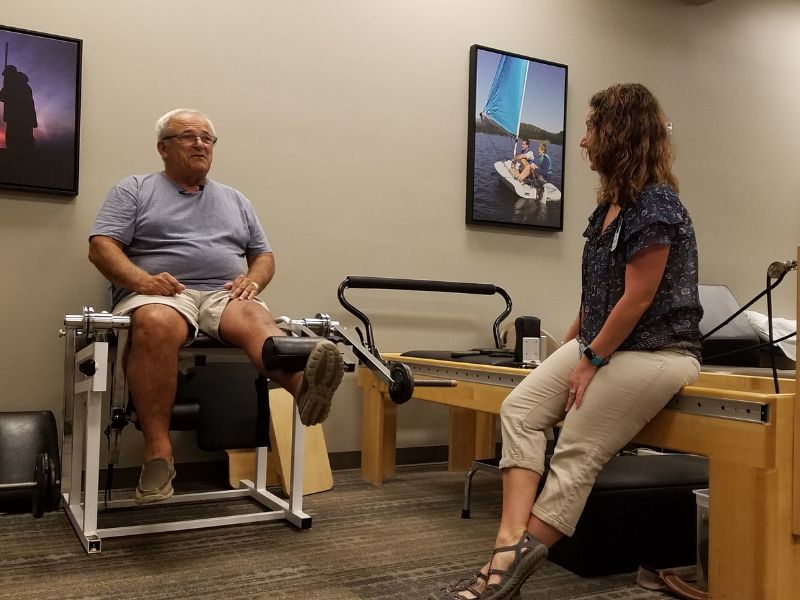Only a month after receiving total knee replacement surgery, 69-year-old Roger Peterson said he’s “walking as close to normal as you can get.”
When it comes to exercise and anything physical, Peterson is very competitive.
“If somebody says ‘oh you can’t do that,’ I would do everything possible to make sure I did it,” he said.
Despite having a determined personality, he gives some credit for his fast recovery to ROSA, a robotic surgical assistant.
“I’m doing things that I don’t think most people could do within this short of time after surgery,” he said.
ROSA surgery reduces patient recovery time
Peterson was one of the first people in the Midwest to receive a total knee replacement surgery via ROSA. Matthew Nelsen, M.D., and his team members at Sanford Orthopedics and Sports Medicine in Fargo performed the operation.
“ROSA increases our precision and gives the surgeon a lot of real-time information during the surgery,” Dr. Nelsen said.
Learn more: Total joint replacement surgeries at Sanford Health
Since Peterson’s surgery, Dr. Nelsen has been pleased with the ROSA technology and said that he has recovered faster than most patients.
Recovery from a regular knee replacement surgery typically takes three months. Peterson only spent one night in the hospital and hasn’t used a walker, crutch or cane since the day after his operation. After four weeks and a few physical therapy sessions, Peterson says he’s walking normally, with minimal stiffness.
Peterson compares his condition to others who’ve had knee replacements.
“Some have spent three or four days in the hospital and used walkers for two or three weeks,” he said.
“It’s hard to say if it (his quick recovery) is completely due to the technology that ROSA provides or simply because of his personal attributes,” Dr. Nelsen said. “Each patient’s experience is different, but Roger has done very well.”
Todd Sekundiak, M.D., orthopedic surgeon at Sanford, also is impressed with Peterson’s results following the procedure using ROSA.
“The way (total knee replacement surgery) changes people’s life is phenomenal,” Dr. Sekundiak said. “People who couldn’t walk, now can walk. People who can’t do their golf game, pick up their grandkids, can now do all that. And with ROSA, we’re trying to take that a step further and allow people to do those activities without even feeling like they had a knee replacement.”
Enlarge

Surgical assistance with ROSA
Surgery assisted with ROSA is unique because the robot can accurately put a replacement implant in the correct position of a patient’s knee. According to Dr. Sekundiak, this is an important but usually difficult task for surgeons to do on their own.
Surgeons are required to receive training to learn how to use ROSA as a tool to provide solutions for each patient’s unique anatomy. So far, eight Sanford surgeons in Fargo have been trained.
“It’s never about the robot magically coming in to do the surgery,” Dr. Sekundiak said. “It’s up to the surgeon to take all this information, come up with the appropriate plan, and then execute that plan so you get the results you want.”
Not knowing much about robotically-assisted surgeries, Peterson trusted Dr. Nelsen’s confidence in ROSA’s capabilities. Dr. Nelson assured Peterson that the procedure would ideally result in a more natural feeling after surgery, since the placement of the implant would be more exact.
“And I think that’s probably why I’m walking around without using a walker,” Peterson said.
Previous experience with knee surgery
This isn’t the first surgery Dr. Nelsen has performed on Peterson.
About 10 years earlier, Dr. Nelsen operated on Peterson’s broken kneecap and told Peterson he’d eventually need a knee replacement.
The time finally came for Peterson in January 2019. Last winter it got to the point where it would take him two or three days to recover just from walking.
“So that’s really when I decided to come back and have the surgery,” he said.
Peterson estimates he will be “good as new” in another month.
“I think I probably could be jogging and walking 18 holes of golf by then,” he said.
Peterson’s goal after surgery was to do some activities without feeling stiff, sore and achy afterwards.
“And to be honest with you, I believe that’s going to happen,” Peterson said.
He said ROSA “is 100 times better than the old way of doing it.”
“I’m just very happy with the surgery and very happy with the people here,” Peterson said. He is also satisfied with people explaining things to him and the therapy he’s received, claiming each week he can feel his progress and that he’s gotten a little stronger.
Future procedures with ROSA
After seeing the outcomes of their first ROSA procedures, the surgeons are optimistic about the success they will have with ROSA in future surgeries.
“It will be exciting see these results we’ve already seen with Roger, not just a week or two after surgery, but a month down the road, three months down the road, and even multiple years down the road,” Dr. Sekundiak said.
“Here at Sanford in Fargo, we’re doing over 2,000 joint replacements a year,” he added. “As we get more experience with ROSA I would anticipate it will be used on more and more patients.”
Right now, Sanford’s Orthopedic and Sports Medicine surgeons are concentrating on knee surgeries with ROSA. But they hope to extend this platform into using it for hip, partial and possibly shoulder replacements.
More stories
- Robotic-assisted surgery is option in hip or knee procedures
- Life after knee replacement surgery: A tale of two knees
- Knee replacement gives retired military vet new mobility
- The big picture: A photographer’s joint replacement journey
…
Posted In Orthopedics, Sports Medicine
